Occupational Health Management and Risk Assessment: Flour Australia
VerifiedAdded on 2023/06/11
|20
|3938
|95
Report
AI Summary
This assignment delves into the critical aspects of occupational health management, particularly within the context of a construction company, Flour Australia. It identifies noise pollution as a significant health hazard, exploring its associated risks, including emotional stress, hearing damage, and cardiovascular issues. The report outlines current management strategies, such as rotational shifts and the use of earplugs, and emphasizes the legal and ethical considerations for ensuring a safe workplace. Furthermore, it proposes a prevention program with goals to reduce employee exposure to high-intensity sound, decrease absenteeism, improve staff performance, and provide effective sound management training. The program includes continuous education for employers and employees, policy implementation, and monitoring tools like anonymous questionnaires and periodic reviews to ensure its effectiveness. This comprehensive approach aims to mitigate health risks and promote a healthier work environment.
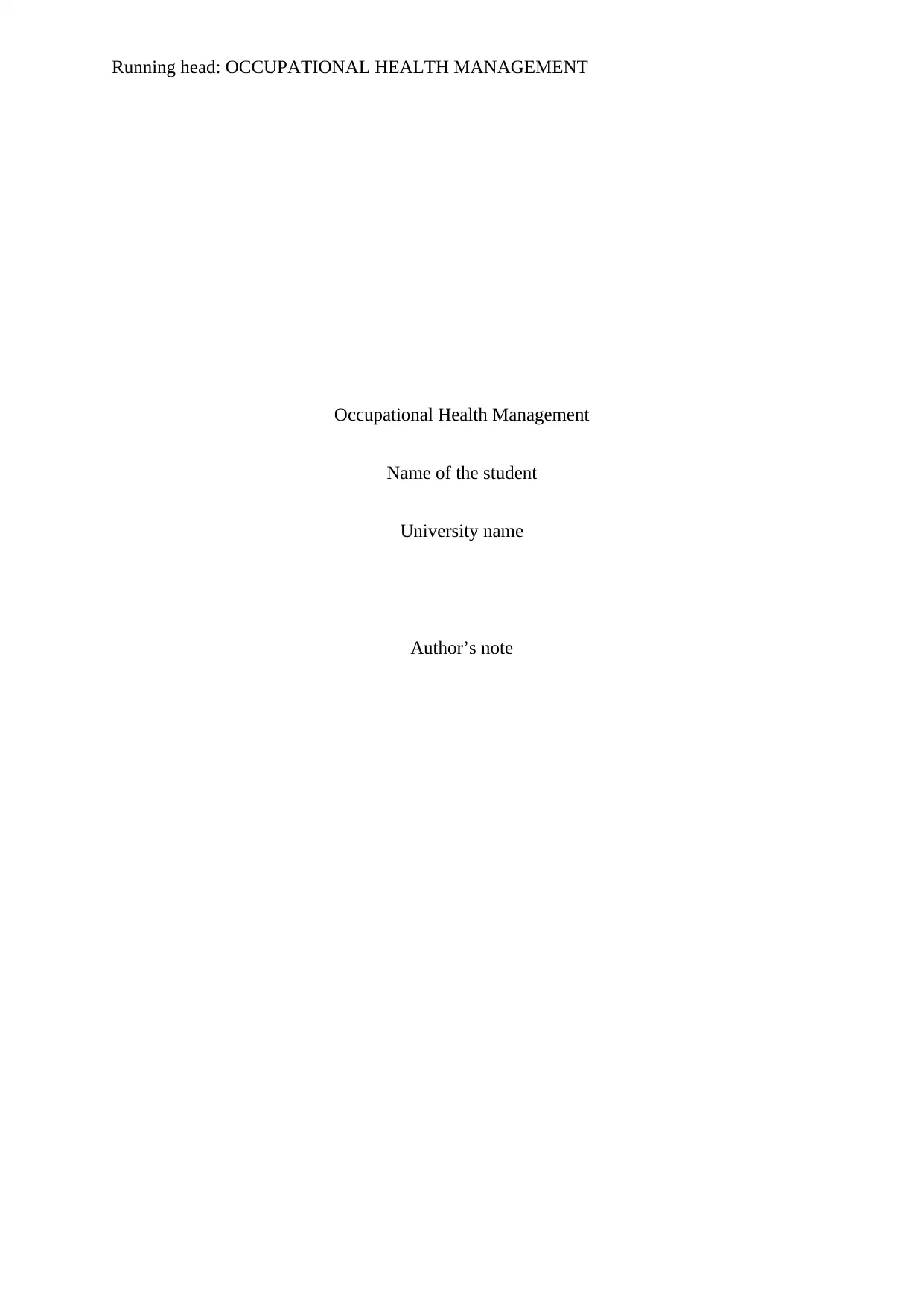
Running head: OCCUPATIONAL HEALTH MANAGEMENT
Occupational Health Management
Name of the student
University name
Author’s note
Occupational Health Management
Name of the student
University name
Author’s note
Paraphrase This Document
Need a fresh take? Get an instant paraphrase of this document with our AI Paraphraser
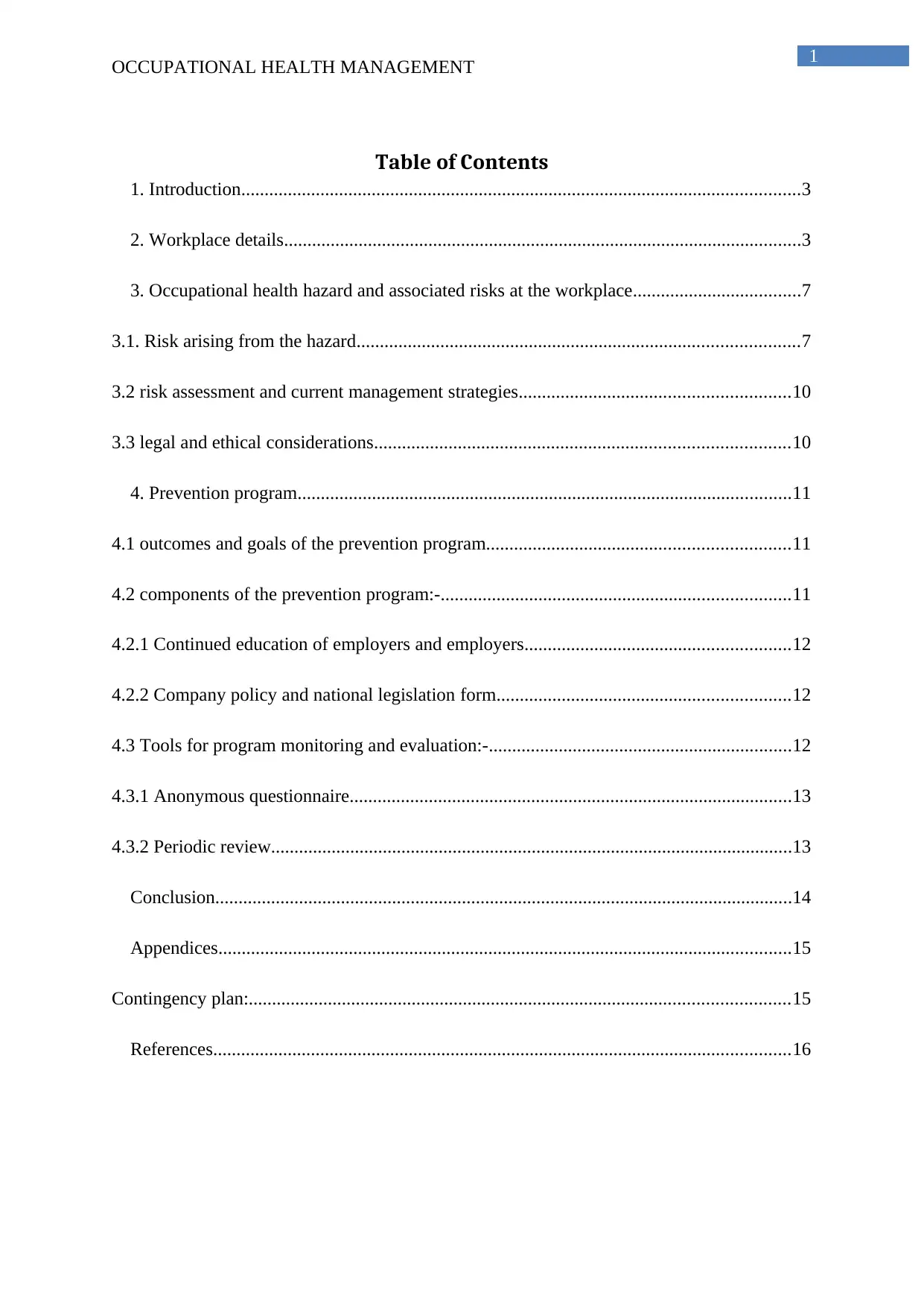
1
OCCUPATIONAL HEALTH MANAGEMENT
Table of Contents
1. Introduction........................................................................................................................3
2. Workplace details...............................................................................................................3
3. Occupational health hazard and associated risks at the workplace....................................7
3.1. Risk arising from the hazard...............................................................................................7
3.2 risk assessment and current management strategies..........................................................10
3.3 legal and ethical considerations.........................................................................................10
4. Prevention program..........................................................................................................11
4.1 outcomes and goals of the prevention program.................................................................11
4.2 components of the prevention program:-...........................................................................11
4.2.1 Continued education of employers and employers.........................................................12
4.2.2 Company policy and national legislation form...............................................................12
4.3 Tools for program monitoring and evaluation:-.................................................................12
4.3.1 Anonymous questionnaire...............................................................................................13
4.3.2 Periodic review................................................................................................................13
Conclusion............................................................................................................................14
Appendices...........................................................................................................................15
Contingency plan:....................................................................................................................15
References............................................................................................................................16
OCCUPATIONAL HEALTH MANAGEMENT
Table of Contents
1. Introduction........................................................................................................................3
2. Workplace details...............................................................................................................3
3. Occupational health hazard and associated risks at the workplace....................................7
3.1. Risk arising from the hazard...............................................................................................7
3.2 risk assessment and current management strategies..........................................................10
3.3 legal and ethical considerations.........................................................................................10
4. Prevention program..........................................................................................................11
4.1 outcomes and goals of the prevention program.................................................................11
4.2 components of the prevention program:-...........................................................................11
4.2.1 Continued education of employers and employers.........................................................12
4.2.2 Company policy and national legislation form...............................................................12
4.3 Tools for program monitoring and evaluation:-.................................................................12
4.3.1 Anonymous questionnaire...............................................................................................13
4.3.2 Periodic review................................................................................................................13
Conclusion............................................................................................................................14
Appendices...........................................................................................................................15
Contingency plan:....................................................................................................................15
References............................................................................................................................16
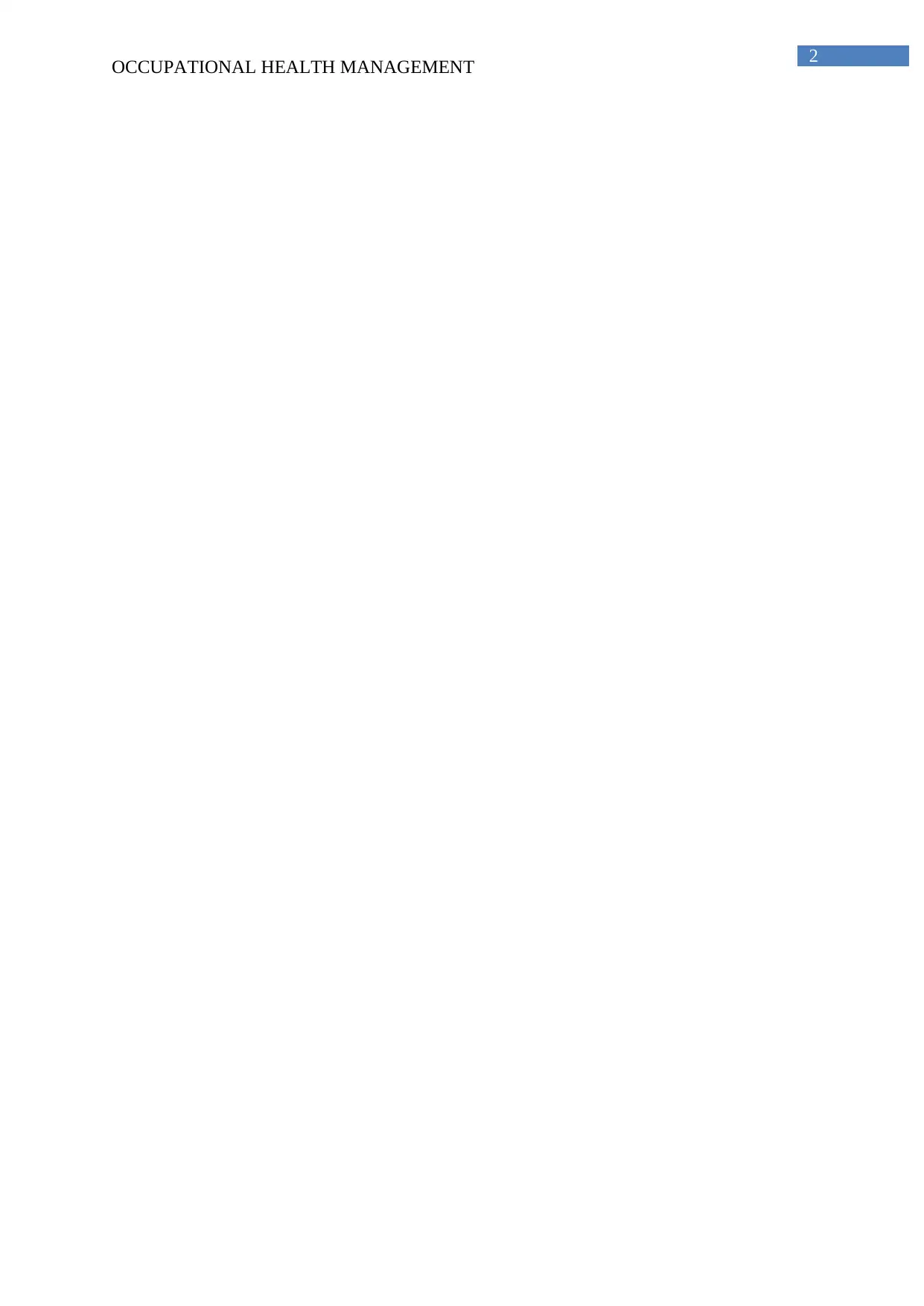
2
OCCUPATIONAL HEALTH MANAGEMENT
OCCUPATIONAL HEALTH MANAGEMENT
⊘ This is a preview!⊘
Do you want full access?
Subscribe today to unlock all pages.

Trusted by 1+ million students worldwide
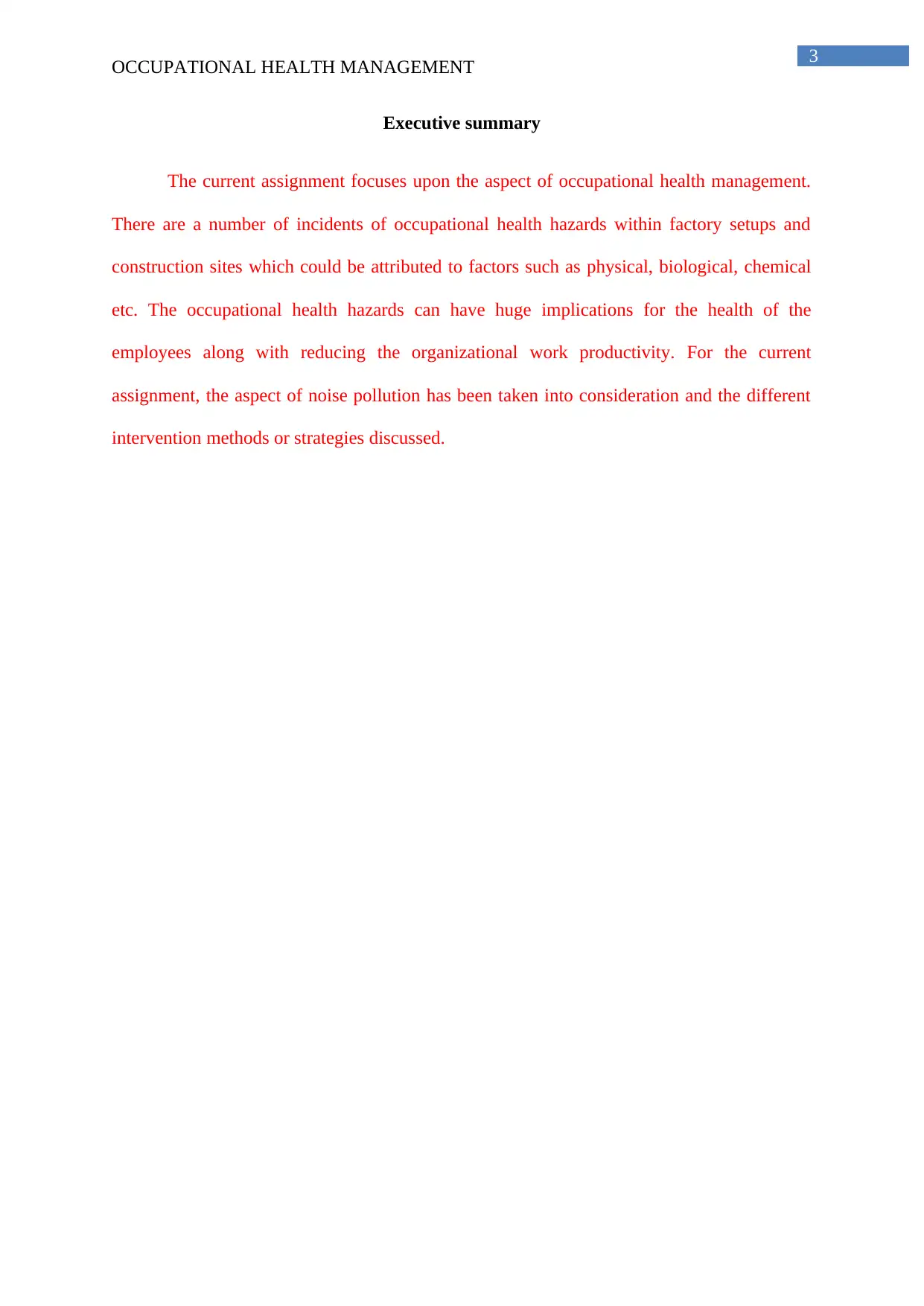
3
OCCUPATIONAL HEALTH MANAGEMENT
Executive summary
The current assignment focuses upon the aspect of occupational health management.
There are a number of incidents of occupational health hazards within factory setups and
construction sites which could be attributed to factors such as physical, biological, chemical
etc. The occupational health hazards can have huge implications for the health of the
employees along with reducing the organizational work productivity. For the current
assignment, the aspect of noise pollution has been taken into consideration and the different
intervention methods or strategies discussed.
OCCUPATIONAL HEALTH MANAGEMENT
Executive summary
The current assignment focuses upon the aspect of occupational health management.
There are a number of incidents of occupational health hazards within factory setups and
construction sites which could be attributed to factors such as physical, biological, chemical
etc. The occupational health hazards can have huge implications for the health of the
employees along with reducing the organizational work productivity. For the current
assignment, the aspect of noise pollution has been taken into consideration and the different
intervention methods or strategies discussed.
Paraphrase This Document
Need a fresh take? Get an instant paraphrase of this document with our AI Paraphraser
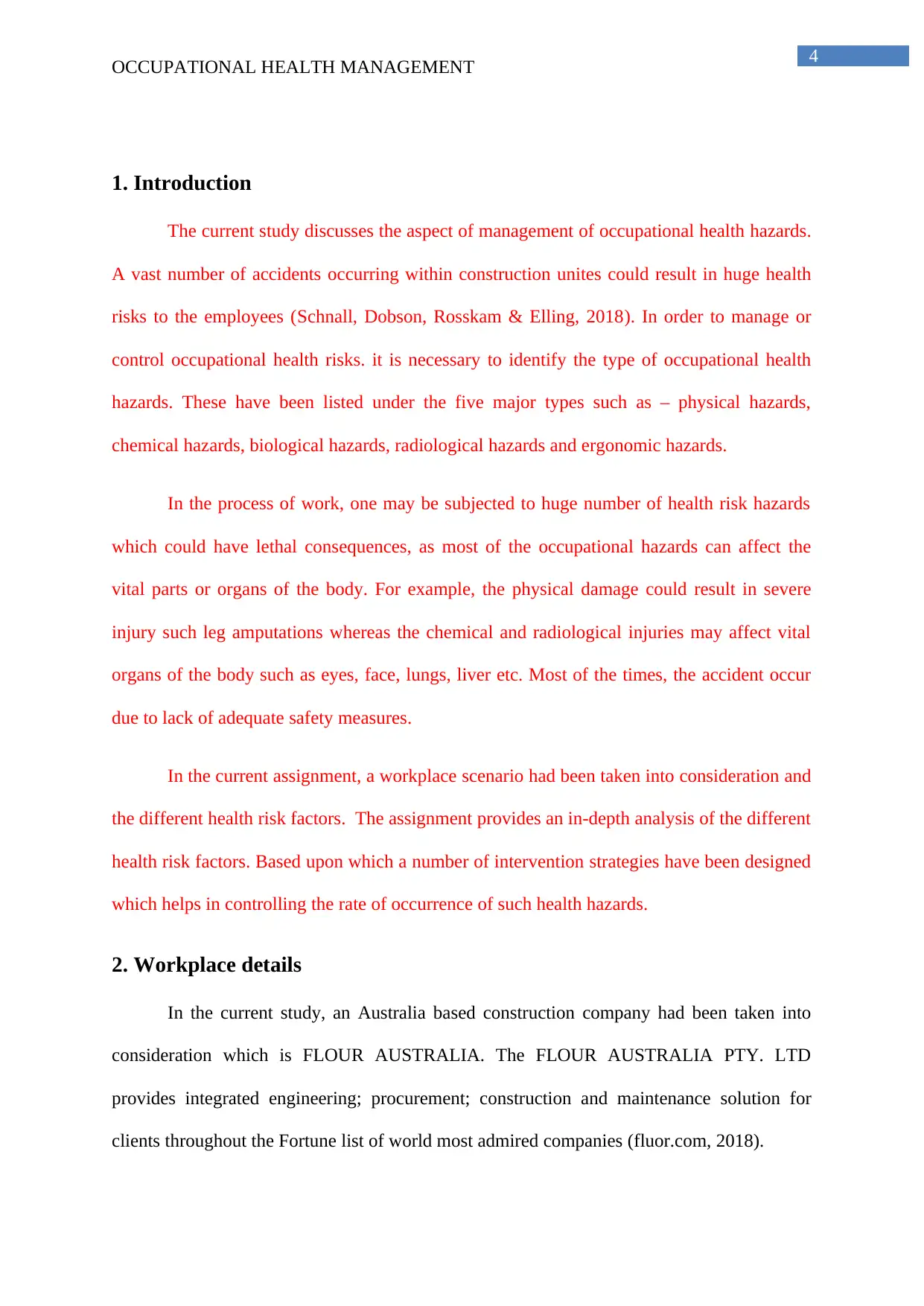
4
OCCUPATIONAL HEALTH MANAGEMENT
1. Introduction
The current study discusses the aspect of management of occupational health hazards.
A vast number of accidents occurring within construction unites could result in huge health
risks to the employees (Schnall, Dobson, Rosskam & Elling, 2018). In order to manage or
control occupational health risks. it is necessary to identify the type of occupational health
hazards. These have been listed under the five major types such as – physical hazards,
chemical hazards, biological hazards, radiological hazards and ergonomic hazards.
In the process of work, one may be subjected to huge number of health risk hazards
which could have lethal consequences, as most of the occupational hazards can affect the
vital parts or organs of the body. For example, the physical damage could result in severe
injury such leg amputations whereas the chemical and radiological injuries may affect vital
organs of the body such as eyes, face, lungs, liver etc. Most of the times, the accident occur
due to lack of adequate safety measures.
In the current assignment, a workplace scenario had been taken into consideration and
the different health risk factors. The assignment provides an in-depth analysis of the different
health risk factors. Based upon which a number of intervention strategies have been designed
which helps in controlling the rate of occurrence of such health hazards.
2. Workplace details
In the current study, an Australia based construction company had been taken into
consideration which is FLOUR AUSTRALIA. The FLOUR AUSTRALIA PTY. LTD
provides integrated engineering; procurement; construction and maintenance solution for
clients throughout the Fortune list of world most admired companies (fluor.com, 2018).
OCCUPATIONAL HEALTH MANAGEMENT
1. Introduction
The current study discusses the aspect of management of occupational health hazards.
A vast number of accidents occurring within construction unites could result in huge health
risks to the employees (Schnall, Dobson, Rosskam & Elling, 2018). In order to manage or
control occupational health risks. it is necessary to identify the type of occupational health
hazards. These have been listed under the five major types such as – physical hazards,
chemical hazards, biological hazards, radiological hazards and ergonomic hazards.
In the process of work, one may be subjected to huge number of health risk hazards
which could have lethal consequences, as most of the occupational hazards can affect the
vital parts or organs of the body. For example, the physical damage could result in severe
injury such leg amputations whereas the chemical and radiological injuries may affect vital
organs of the body such as eyes, face, lungs, liver etc. Most of the times, the accident occur
due to lack of adequate safety measures.
In the current assignment, a workplace scenario had been taken into consideration and
the different health risk factors. The assignment provides an in-depth analysis of the different
health risk factors. Based upon which a number of intervention strategies have been designed
which helps in controlling the rate of occurrence of such health hazards.
2. Workplace details
In the current study, an Australia based construction company had been taken into
consideration which is FLOUR AUSTRALIA. The FLOUR AUSTRALIA PTY. LTD
provides integrated engineering; procurement; construction and maintenance solution for
clients throughout the Fortune list of world most admired companies (fluor.com, 2018).
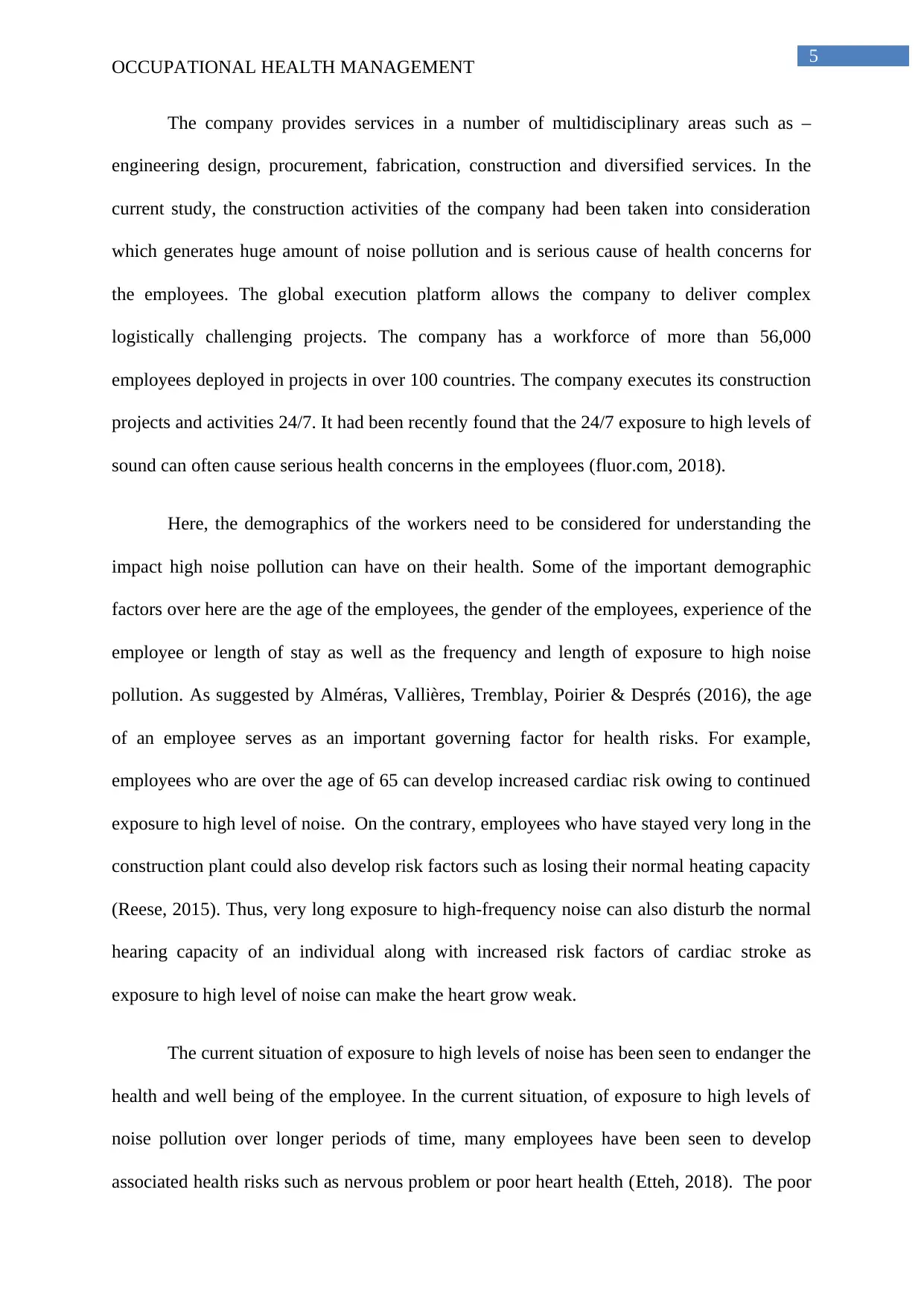
5
OCCUPATIONAL HEALTH MANAGEMENT
The company provides services in a number of multidisciplinary areas such as –
engineering design, procurement, fabrication, construction and diversified services. In the
current study, the construction activities of the company had been taken into consideration
which generates huge amount of noise pollution and is serious cause of health concerns for
the employees. The global execution platform allows the company to deliver complex
logistically challenging projects. The company has a workforce of more than 56,000
employees deployed in projects in over 100 countries. The company executes its construction
projects and activities 24/7. It had been recently found that the 24/7 exposure to high levels of
sound can often cause serious health concerns in the employees (fluor.com, 2018).
Here, the demographics of the workers need to be considered for understanding the
impact high noise pollution can have on their health. Some of the important demographic
factors over here are the age of the employees, the gender of the employees, experience of the
employee or length of stay as well as the frequency and length of exposure to high noise
pollution. As suggested by Alméras, Vallières, Tremblay, Poirier & Després (2016), the age
of an employee serves as an important governing factor for health risks. For example,
employees who are over the age of 65 can develop increased cardiac risk owing to continued
exposure to high level of noise. On the contrary, employees who have stayed very long in the
construction plant could also develop risk factors such as losing their normal heating capacity
(Reese, 2015). Thus, very long exposure to high-frequency noise can also disturb the normal
hearing capacity of an individual along with increased risk factors of cardiac stroke as
exposure to high level of noise can make the heart grow weak.
The current situation of exposure to high levels of noise has been seen to endanger the
health and well being of the employee. In the current situation, of exposure to high levels of
noise pollution over longer periods of time, many employees have been seen to develop
associated health risks such as nervous problem or poor heart health (Etteh, 2018). The poor
OCCUPATIONAL HEALTH MANAGEMENT
The company provides services in a number of multidisciplinary areas such as –
engineering design, procurement, fabrication, construction and diversified services. In the
current study, the construction activities of the company had been taken into consideration
which generates huge amount of noise pollution and is serious cause of health concerns for
the employees. The global execution platform allows the company to deliver complex
logistically challenging projects. The company has a workforce of more than 56,000
employees deployed in projects in over 100 countries. The company executes its construction
projects and activities 24/7. It had been recently found that the 24/7 exposure to high levels of
sound can often cause serious health concerns in the employees (fluor.com, 2018).
Here, the demographics of the workers need to be considered for understanding the
impact high noise pollution can have on their health. Some of the important demographic
factors over here are the age of the employees, the gender of the employees, experience of the
employee or length of stay as well as the frequency and length of exposure to high noise
pollution. As suggested by Alméras, Vallières, Tremblay, Poirier & Després (2016), the age
of an employee serves as an important governing factor for health risks. For example,
employees who are over the age of 65 can develop increased cardiac risk owing to continued
exposure to high level of noise. On the contrary, employees who have stayed very long in the
construction plant could also develop risk factors such as losing their normal heating capacity
(Reese, 2015). Thus, very long exposure to high-frequency noise can also disturb the normal
hearing capacity of an individual along with increased risk factors of cardiac stroke as
exposure to high level of noise can make the heart grow weak.
The current situation of exposure to high levels of noise has been seen to endanger the
health and well being of the employee. In the current situation, of exposure to high levels of
noise pollution over longer periods of time, many employees have been seen to develop
associated health risks such as nervous problem or poor heart health (Etteh, 2018). The poor
⊘ This is a preview!⊘
Do you want full access?
Subscribe today to unlock all pages.

Trusted by 1+ million students worldwide
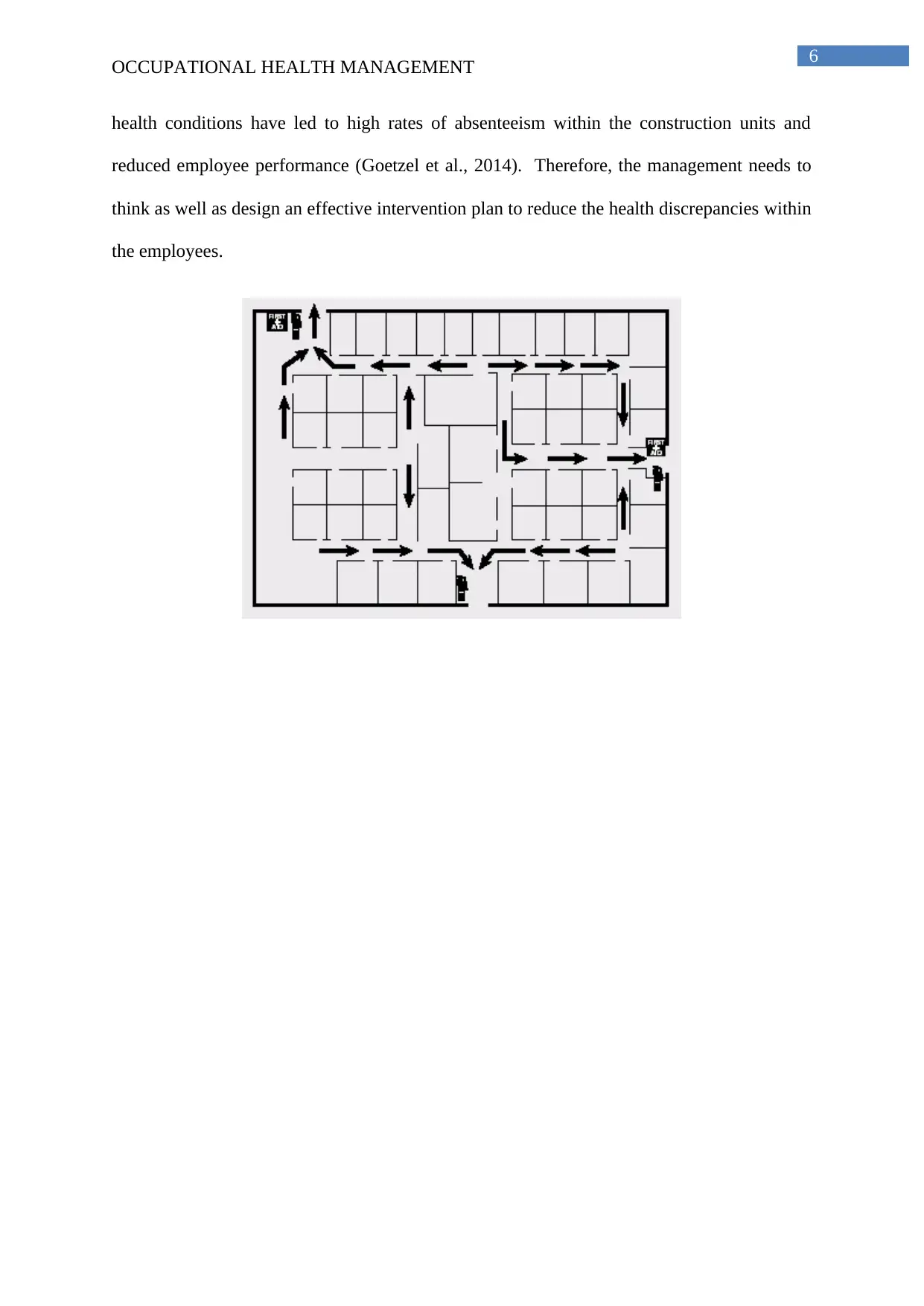
6
OCCUPATIONAL HEALTH MANAGEMENT
health conditions have led to high rates of absenteeism within the construction units and
reduced employee performance (Goetzel et al., 2014). Therefore, the management needs to
think as well as design an effective intervention plan to reduce the health discrepancies within
the employees.
OCCUPATIONAL HEALTH MANAGEMENT
health conditions have led to high rates of absenteeism within the construction units and
reduced employee performance (Goetzel et al., 2014). Therefore, the management needs to
think as well as design an effective intervention plan to reduce the health discrepancies within
the employees.
Paraphrase This Document
Need a fresh take? Get an instant paraphrase of this document with our AI Paraphraser
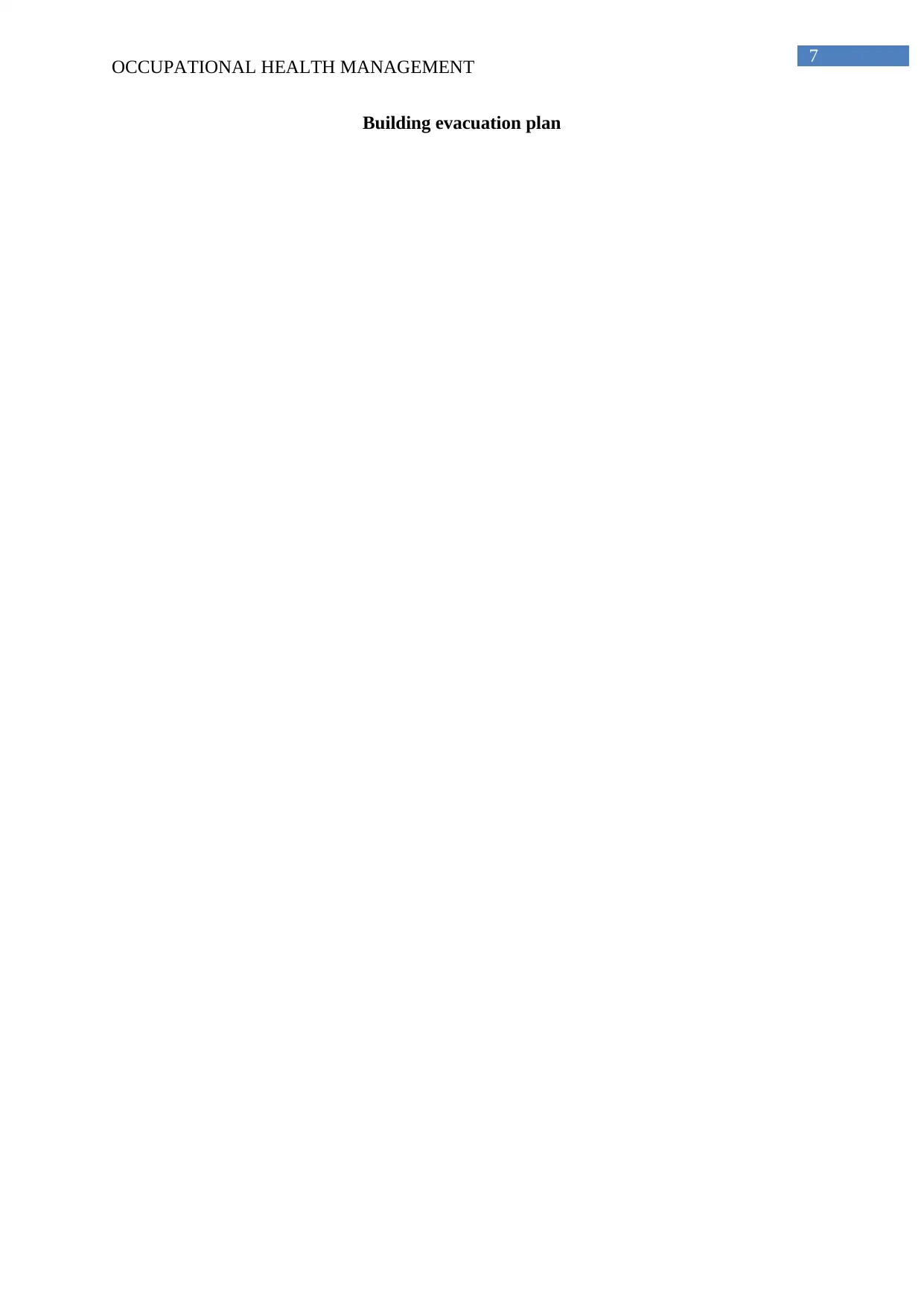
7
OCCUPATIONAL HEALTH MANAGEMENT
Building evacuation plan
OCCUPATIONAL HEALTH MANAGEMENT
Building evacuation plan
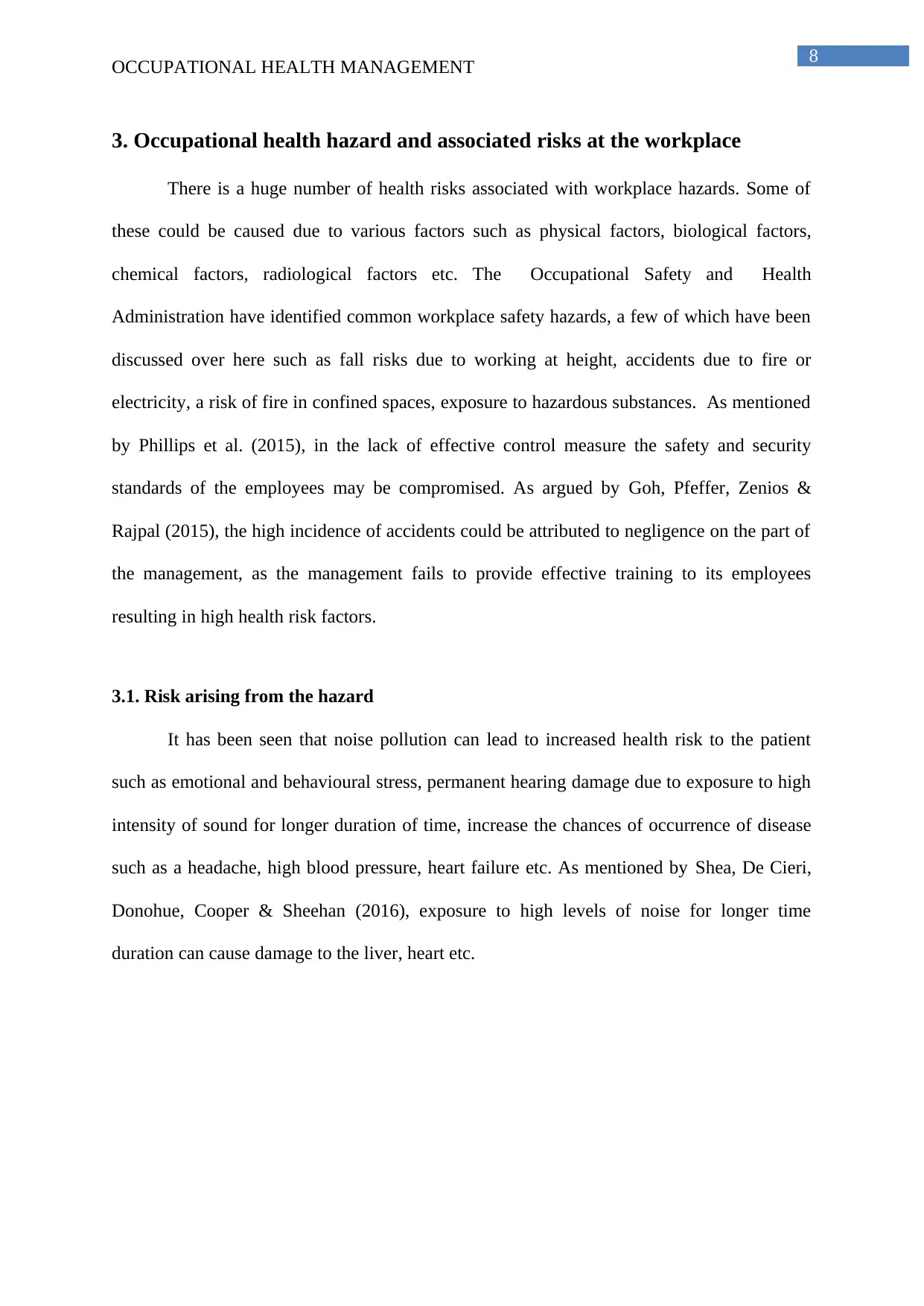
8
OCCUPATIONAL HEALTH MANAGEMENT
3. Occupational health hazard and associated risks at the workplace
There is a huge number of health risks associated with workplace hazards. Some of
these could be caused due to various factors such as physical factors, biological factors,
chemical factors, radiological factors etc. The Occupational Safety and Health
Administration have identified common workplace safety hazards, a few of which have been
discussed over here such as fall risks due to working at height, accidents due to fire or
electricity, a risk of fire in confined spaces, exposure to hazardous substances. As mentioned
by Phillips et al. (2015), in the lack of effective control measure the safety and security
standards of the employees may be compromised. As argued by Goh, Pfeffer, Zenios &
Rajpal (2015), the high incidence of accidents could be attributed to negligence on the part of
the management, as the management fails to provide effective training to its employees
resulting in high health risk factors.
3.1. Risk arising from the hazard
It has been seen that noise pollution can lead to increased health risk to the patient
such as emotional and behavioural stress, permanent hearing damage due to exposure to high
intensity of sound for longer duration of time, increase the chances of occurrence of disease
such as a headache, high blood pressure, heart failure etc. As mentioned by Shea, De Cieri,
Donohue, Cooper & Sheehan (2016), exposure to high levels of noise for longer time
duration can cause damage to the liver, heart etc.
OCCUPATIONAL HEALTH MANAGEMENT
3. Occupational health hazard and associated risks at the workplace
There is a huge number of health risks associated with workplace hazards. Some of
these could be caused due to various factors such as physical factors, biological factors,
chemical factors, radiological factors etc. The Occupational Safety and Health
Administration have identified common workplace safety hazards, a few of which have been
discussed over here such as fall risks due to working at height, accidents due to fire or
electricity, a risk of fire in confined spaces, exposure to hazardous substances. As mentioned
by Phillips et al. (2015), in the lack of effective control measure the safety and security
standards of the employees may be compromised. As argued by Goh, Pfeffer, Zenios &
Rajpal (2015), the high incidence of accidents could be attributed to negligence on the part of
the management, as the management fails to provide effective training to its employees
resulting in high health risk factors.
3.1. Risk arising from the hazard
It has been seen that noise pollution can lead to increased health risk to the patient
such as emotional and behavioural stress, permanent hearing damage due to exposure to high
intensity of sound for longer duration of time, increase the chances of occurrence of disease
such as a headache, high blood pressure, heart failure etc. As mentioned by Shea, De Cieri,
Donohue, Cooper & Sheehan (2016), exposure to high levels of noise for longer time
duration can cause damage to the liver, heart etc.
⊘ This is a preview!⊘
Do you want full access?
Subscribe today to unlock all pages.

Trusted by 1+ million students worldwide
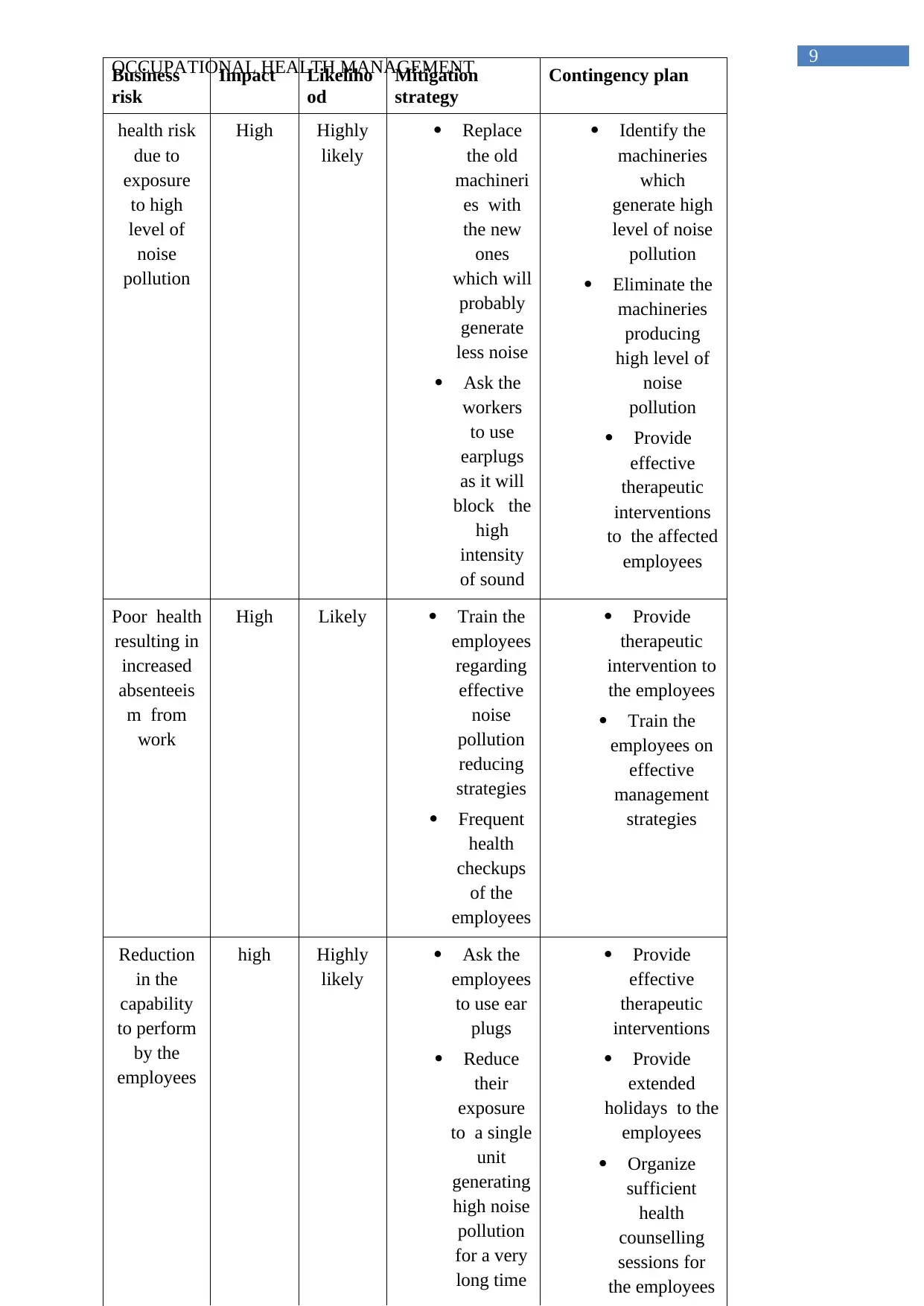
9
OCCUPATIONAL HEALTH MANAGEMENTBusiness
risk
Impact Likeliho
od
Mitigation
strategy
Contingency plan
health risk
due to
exposure
to high
level of
noise
pollution
High Highly
likely
Replace
the old
machineri
es with
the new
ones
which will
probably
generate
less noise
Ask the
workers
to use
earplugs
as it will
block the
high
intensity
of sound
Identify the
machineries
which
generate high
level of noise
pollution
Eliminate the
machineries
producing
high level of
noise
pollution
Provide
effective
therapeutic
interventions
to the affected
employees
Poor health
resulting in
increased
absenteeis
m from
work
High Likely Train the
employees
regarding
effective
noise
pollution
reducing
strategies
Frequent
health
checkups
of the
employees
Provide
therapeutic
intervention to
the employees
Train the
employees on
effective
management
strategies
Reduction
in the
capability
to perform
by the
employees
high Highly
likely
Ask the
employees
to use ear
plugs
Reduce
their
exposure
to a single
unit
generating
high noise
pollution
for a very
long time
Provide
effective
therapeutic
interventions
Provide
extended
holidays to the
employees
Organize
sufficient
health
counselling
sessions for
the employees
OCCUPATIONAL HEALTH MANAGEMENTBusiness
risk
Impact Likeliho
od
Mitigation
strategy
Contingency plan
health risk
due to
exposure
to high
level of
noise
pollution
High Highly
likely
Replace
the old
machineri
es with
the new
ones
which will
probably
generate
less noise
Ask the
workers
to use
earplugs
as it will
block the
high
intensity
of sound
Identify the
machineries
which
generate high
level of noise
pollution
Eliminate the
machineries
producing
high level of
noise
pollution
Provide
effective
therapeutic
interventions
to the affected
employees
Poor health
resulting in
increased
absenteeis
m from
work
High Likely Train the
employees
regarding
effective
noise
pollution
reducing
strategies
Frequent
health
checkups
of the
employees
Provide
therapeutic
intervention to
the employees
Train the
employees on
effective
management
strategies
Reduction
in the
capability
to perform
by the
employees
high Highly
likely
Ask the
employees
to use ear
plugs
Reduce
their
exposure
to a single
unit
generating
high noise
pollution
for a very
long time
Provide
effective
therapeutic
interventions
Provide
extended
holidays to the
employees
Organize
sufficient
health
counselling
sessions for
the employees
Paraphrase This Document
Need a fresh take? Get an instant paraphrase of this document with our AI Paraphraser
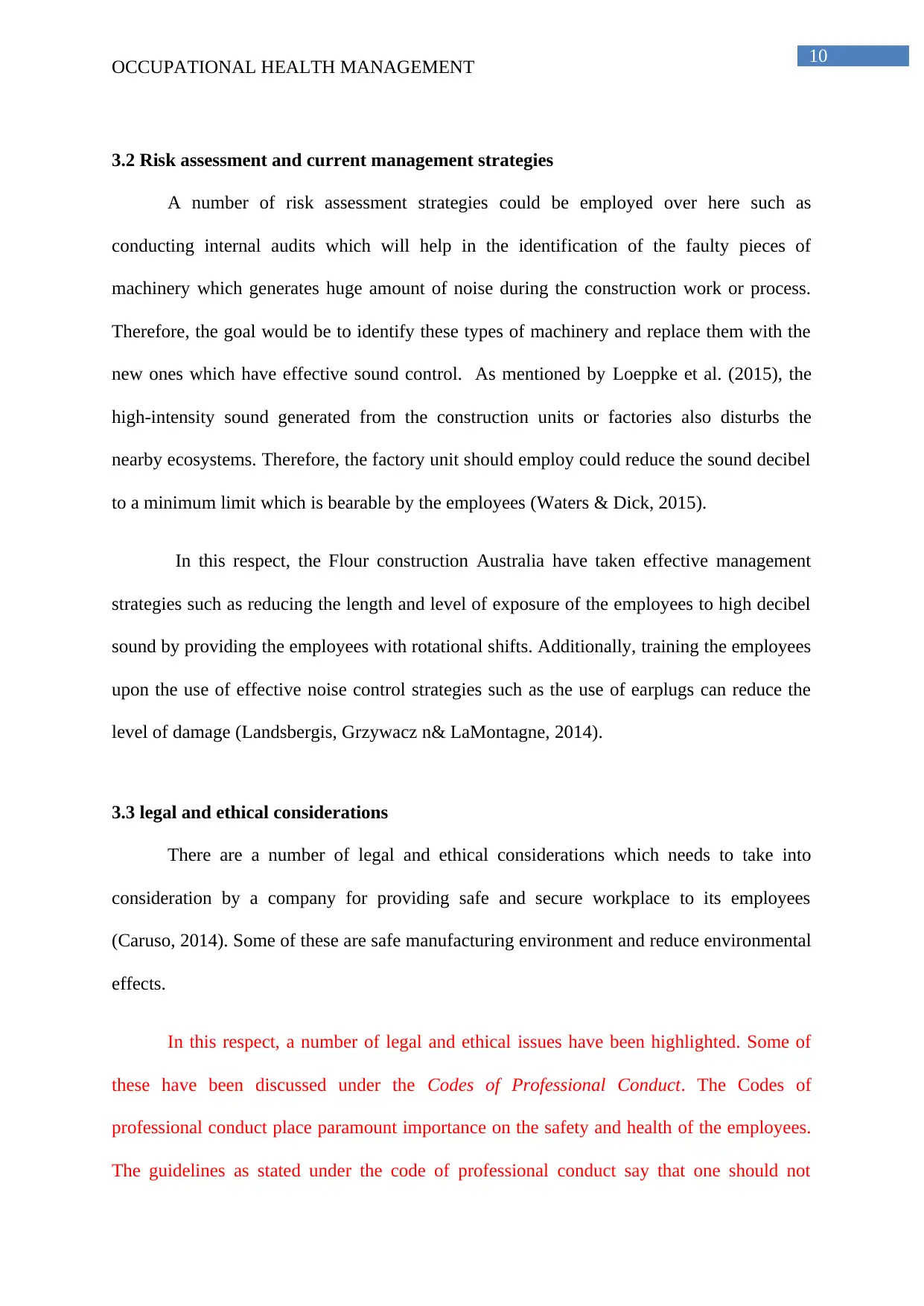
10
OCCUPATIONAL HEALTH MANAGEMENT
3.2 Risk assessment and current management strategies
A number of risk assessment strategies could be employed over here such as
conducting internal audits which will help in the identification of the faulty pieces of
machinery which generates huge amount of noise during the construction work or process.
Therefore, the goal would be to identify these types of machinery and replace them with the
new ones which have effective sound control. As mentioned by Loeppke et al. (2015), the
high-intensity sound generated from the construction units or factories also disturbs the
nearby ecosystems. Therefore, the factory unit should employ could reduce the sound decibel
to a minimum limit which is bearable by the employees (Waters & Dick, 2015).
In this respect, the Flour construction Australia have taken effective management
strategies such as reducing the length and level of exposure of the employees to high decibel
sound by providing the employees with rotational shifts. Additionally, training the employees
upon the use of effective noise control strategies such as the use of earplugs can reduce the
level of damage (Landsbergis, Grzywacz n& LaMontagne, 2014).
3.3 legal and ethical considerations
There are a number of legal and ethical considerations which needs to take into
consideration by a company for providing safe and secure workplace to its employees
(Caruso, 2014). Some of these are safe manufacturing environment and reduce environmental
effects.
In this respect, a number of legal and ethical issues have been highlighted. Some of
these have been discussed under the Codes of Professional Conduct. The Codes of
professional conduct place paramount importance on the safety and health of the employees.
The guidelines as stated under the code of professional conduct say that one should not
OCCUPATIONAL HEALTH MANAGEMENT
3.2 Risk assessment and current management strategies
A number of risk assessment strategies could be employed over here such as
conducting internal audits which will help in the identification of the faulty pieces of
machinery which generates huge amount of noise during the construction work or process.
Therefore, the goal would be to identify these types of machinery and replace them with the
new ones which have effective sound control. As mentioned by Loeppke et al. (2015), the
high-intensity sound generated from the construction units or factories also disturbs the
nearby ecosystems. Therefore, the factory unit should employ could reduce the sound decibel
to a minimum limit which is bearable by the employees (Waters & Dick, 2015).
In this respect, the Flour construction Australia have taken effective management
strategies such as reducing the length and level of exposure of the employees to high decibel
sound by providing the employees with rotational shifts. Additionally, training the employees
upon the use of effective noise control strategies such as the use of earplugs can reduce the
level of damage (Landsbergis, Grzywacz n& LaMontagne, 2014).
3.3 legal and ethical considerations
There are a number of legal and ethical considerations which needs to take into
consideration by a company for providing safe and secure workplace to its employees
(Caruso, 2014). Some of these are safe manufacturing environment and reduce environmental
effects.
In this respect, a number of legal and ethical issues have been highlighted. Some of
these have been discussed under the Codes of Professional Conduct. The Codes of
professional conduct place paramount importance on the safety and health of the employees.
The guidelines as stated under the code of professional conduct say that one should not
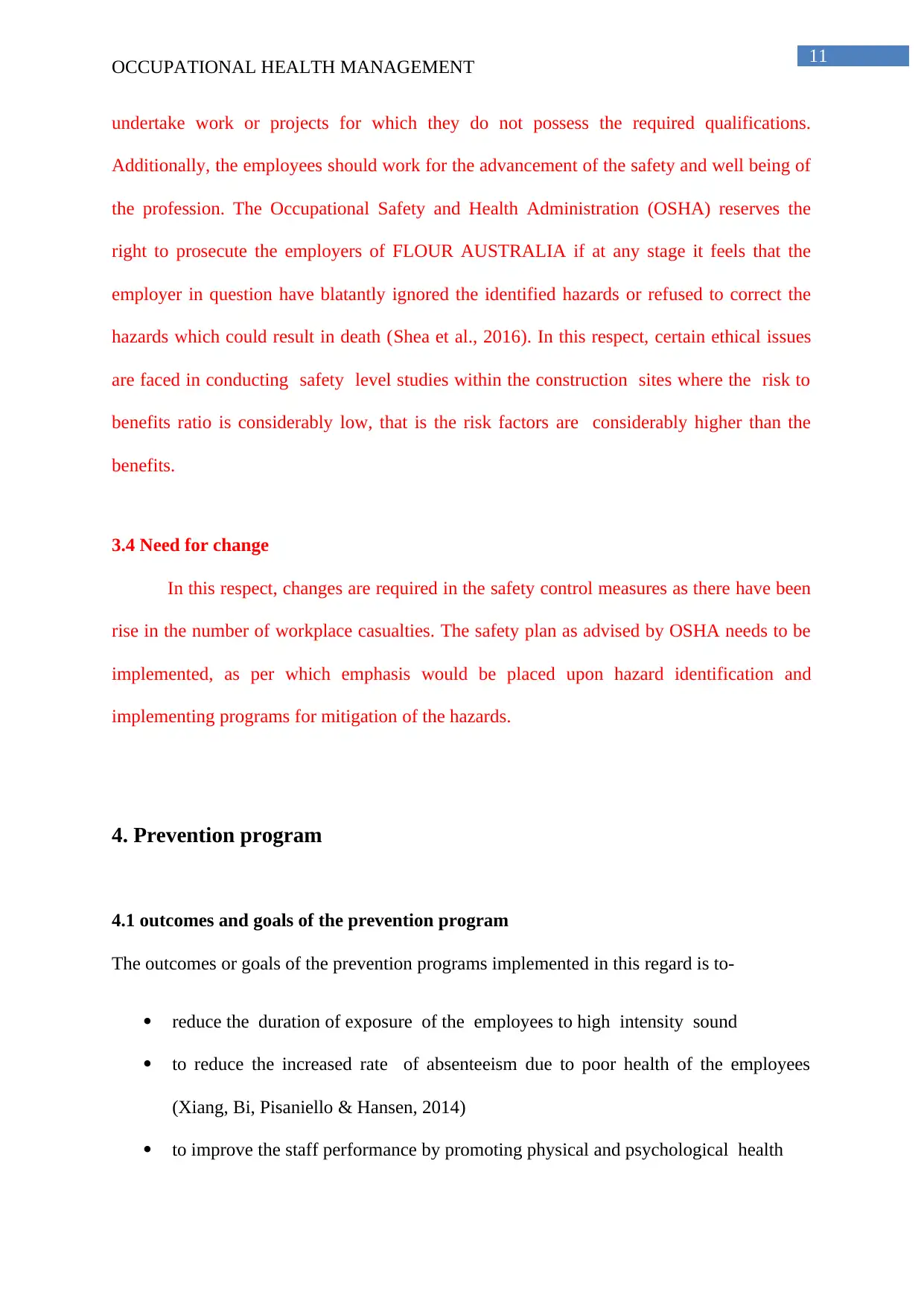
11
OCCUPATIONAL HEALTH MANAGEMENT
undertake work or projects for which they do not possess the required qualifications.
Additionally, the employees should work for the advancement of the safety and well being of
the profession. The Occupational Safety and Health Administration (OSHA) reserves the
right to prosecute the employers of FLOUR AUSTRALIA if at any stage it feels that the
employer in question have blatantly ignored the identified hazards or refused to correct the
hazards which could result in death (Shea et al., 2016). In this respect, certain ethical issues
are faced in conducting safety level studies within the construction sites where the risk to
benefits ratio is considerably low, that is the risk factors are considerably higher than the
benefits.
3.4 Need for change
In this respect, changes are required in the safety control measures as there have been
rise in the number of workplace casualties. The safety plan as advised by OSHA needs to be
implemented, as per which emphasis would be placed upon hazard identification and
implementing programs for mitigation of the hazards.
4. Prevention program
4.1 outcomes and goals of the prevention program
The outcomes or goals of the prevention programs implemented in this regard is to-
reduce the duration of exposure of the employees to high intensity sound
to reduce the increased rate of absenteeism due to poor health of the employees
(Xiang, Bi, Pisaniello & Hansen, 2014)
to improve the staff performance by promoting physical and psychological health
OCCUPATIONAL HEALTH MANAGEMENT
undertake work or projects for which they do not possess the required qualifications.
Additionally, the employees should work for the advancement of the safety and well being of
the profession. The Occupational Safety and Health Administration (OSHA) reserves the
right to prosecute the employers of FLOUR AUSTRALIA if at any stage it feels that the
employer in question have blatantly ignored the identified hazards or refused to correct the
hazards which could result in death (Shea et al., 2016). In this respect, certain ethical issues
are faced in conducting safety level studies within the construction sites where the risk to
benefits ratio is considerably low, that is the risk factors are considerably higher than the
benefits.
3.4 Need for change
In this respect, changes are required in the safety control measures as there have been
rise in the number of workplace casualties. The safety plan as advised by OSHA needs to be
implemented, as per which emphasis would be placed upon hazard identification and
implementing programs for mitigation of the hazards.
4. Prevention program
4.1 outcomes and goals of the prevention program
The outcomes or goals of the prevention programs implemented in this regard is to-
reduce the duration of exposure of the employees to high intensity sound
to reduce the increased rate of absenteeism due to poor health of the employees
(Xiang, Bi, Pisaniello & Hansen, 2014)
to improve the staff performance by promoting physical and psychological health
⊘ This is a preview!⊘
Do you want full access?
Subscribe today to unlock all pages.

Trusted by 1+ million students worldwide
1 out of 20
Related Documents
Your All-in-One AI-Powered Toolkit for Academic Success.
+13062052269
info@desklib.com
Available 24*7 on WhatsApp / Email
![[object Object]](/_next/static/media/star-bottom.7253800d.svg)
Unlock your academic potential
Copyright © 2020–2025 A2Z Services. All Rights Reserved. Developed and managed by ZUCOL.




